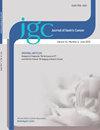Larger Remaining Stomach Volume Is Associated With Better Nutrition and Muscle Preservation in Patients With Gastric Cancer Receiving Distal Gastrectomy With Gastroduodenostomy
IF 3.2
4区 医学
Q2 GASTROENTEROLOGY & HEPATOLOGY
引用次数: 2
Abstract
Purpose Weight loss and deterioration in body composition are observed in patients with gastric cancer (GC) following gastrectomy. This study aimed to investigate the impact of residual stomach volume (RSV) on the nutritional status and body composition of patients with GC treated with distal gastrectomy. Materials and Methods In total, 227 patients who underwent minimally invasive distal gastrectomy with Billroth 1 anastomosis for stage I GC between February 2015 and May 2018 were enrolled. Clinicodemographic and laboratory data were collected from the GC registry. The RSV, abdominal muscle area, and subcutaneous/visceral fat areas were measured using computed tomography data. Results A larger RSV was associated with a lower decrease in the nutritional risk index (P=0.004) and hemoglobin level (P=0.003) during the first 3 months after surgery, and better recovery at 12 months. A larger RSV demonstrated an advantage in the preservation of abdominal muscle area (P=0.02) and visceral fat (P=0.04) after surgery, as well as less reduction in weight (P=0.02) and body mass index (P=0.03). Conclusions Larger RSV was associated with improved nutritional status and better preservation of muscle and fat after distal gastrectomy.在接受远端胃切除术并胃十二指肠吻合术的胃癌患者中,更大的剩余胃容量与更好的营养和肌肉保存有关
目的观察胃癌(GC)患者胃切除术后体重下降和体成分恶化。本研究旨在探讨残胃体积(RSV)对胃癌远端切除术患者营养状况和体组成的影响。材料与方法在2015年2月至2018年5月期间接受微创胃远端切除术并Billroth 1吻合术治疗I期胃癌的患者共227例。临床人口学和实验室数据从GC登记处收集。RSV、腹肌面积和皮下/内脏脂肪面积使用计算机断层扫描数据测量。结果RSV越大,术后前3个月营养风险指数下降(P=0.004)和血红蛋白水平下降(P=0.003)越低,术后12个月恢复越好。较大的RSV在术后腹肌面积(P=0.02)和内脏脂肪(P=0.04)的保存方面具有优势,体重(P=0.02)和体重指数(P=0.03)的减少较少。结论较大的RSV与远端胃切除术后营养状况的改善以及肌肉和脂肪的更好保存有关。
本文章由计算机程序翻译,如有差异,请以英文原文为准。
求助全文
约1分钟内获得全文
求助全文
来源期刊

Journal of Gastric Cancer
Biochemistry, Genetics and Molecular Biology-Cancer Research
CiteScore
4.30
自引率
12.00%
发文量
36
期刊介绍:
The Journal of Gastric Cancer (J Gastric Cancer) is an international peer-reviewed journal. Each issue carries high quality clinical and translational researches on gastric neoplasms. Editorial Board of J Gastric Cancer publishes original articles on pathophysiology, molecular oncology, diagnosis, treatment, and prevention of gastric cancer as well as articles on dietary control and improving the quality of life for gastric cancer patients. J Gastric Cancer includes case reports, review articles, how I do it articles, editorials, and letters to the editor.
 求助内容:
求助内容: 应助结果提醒方式:
应助结果提醒方式:


